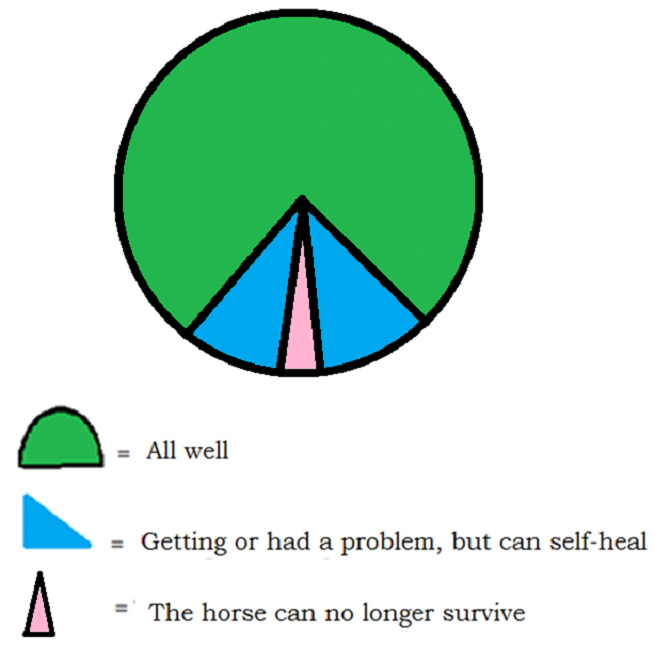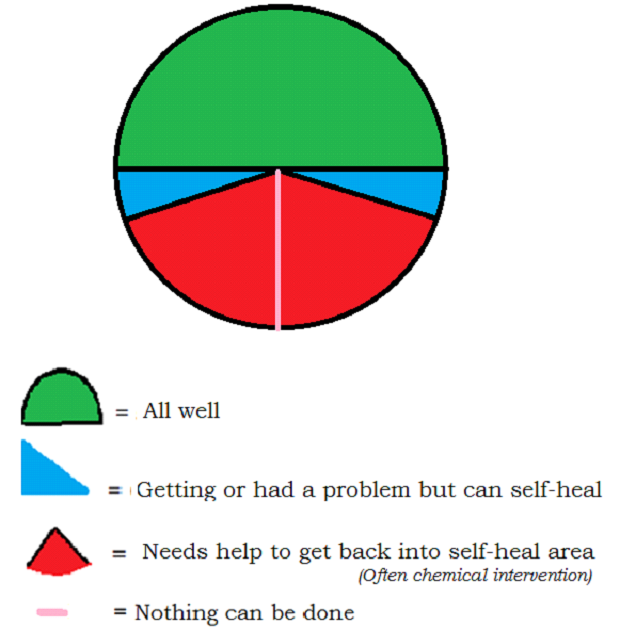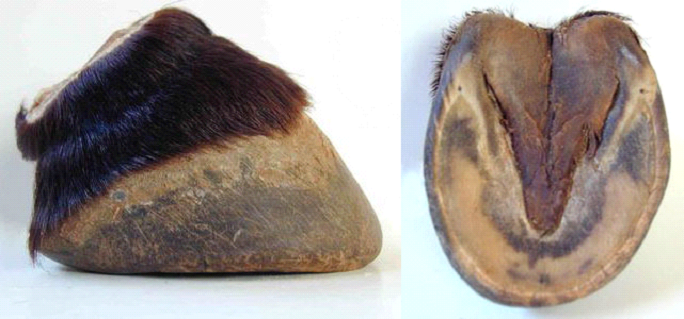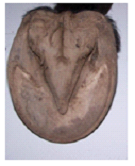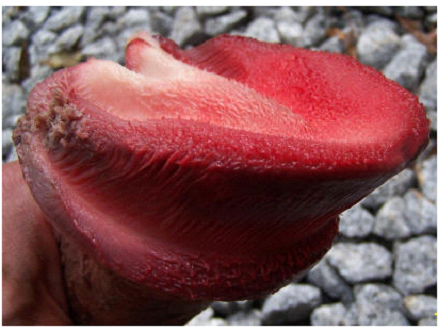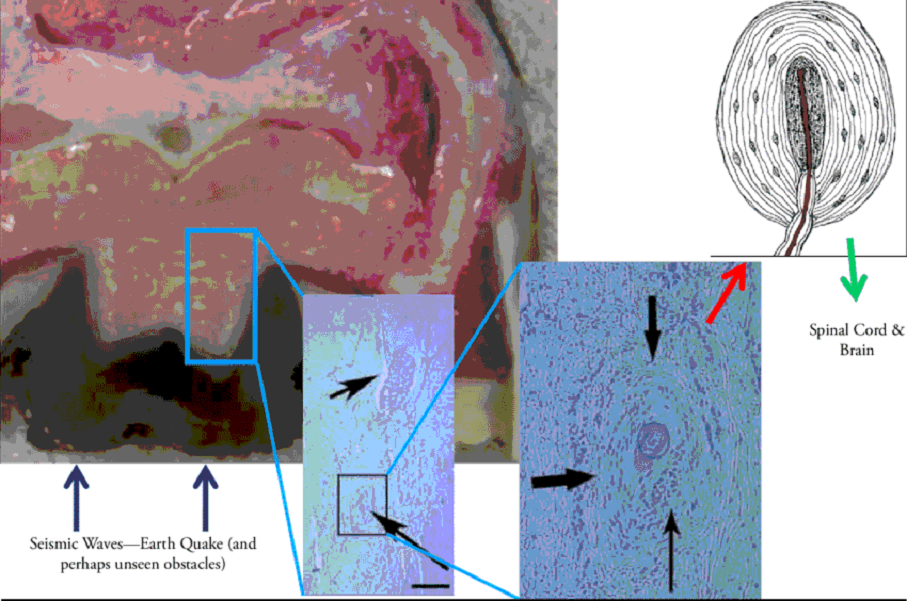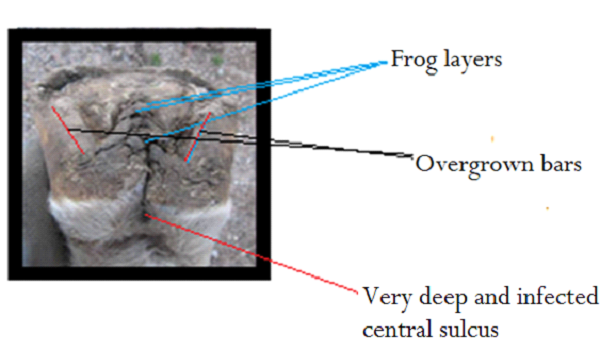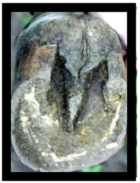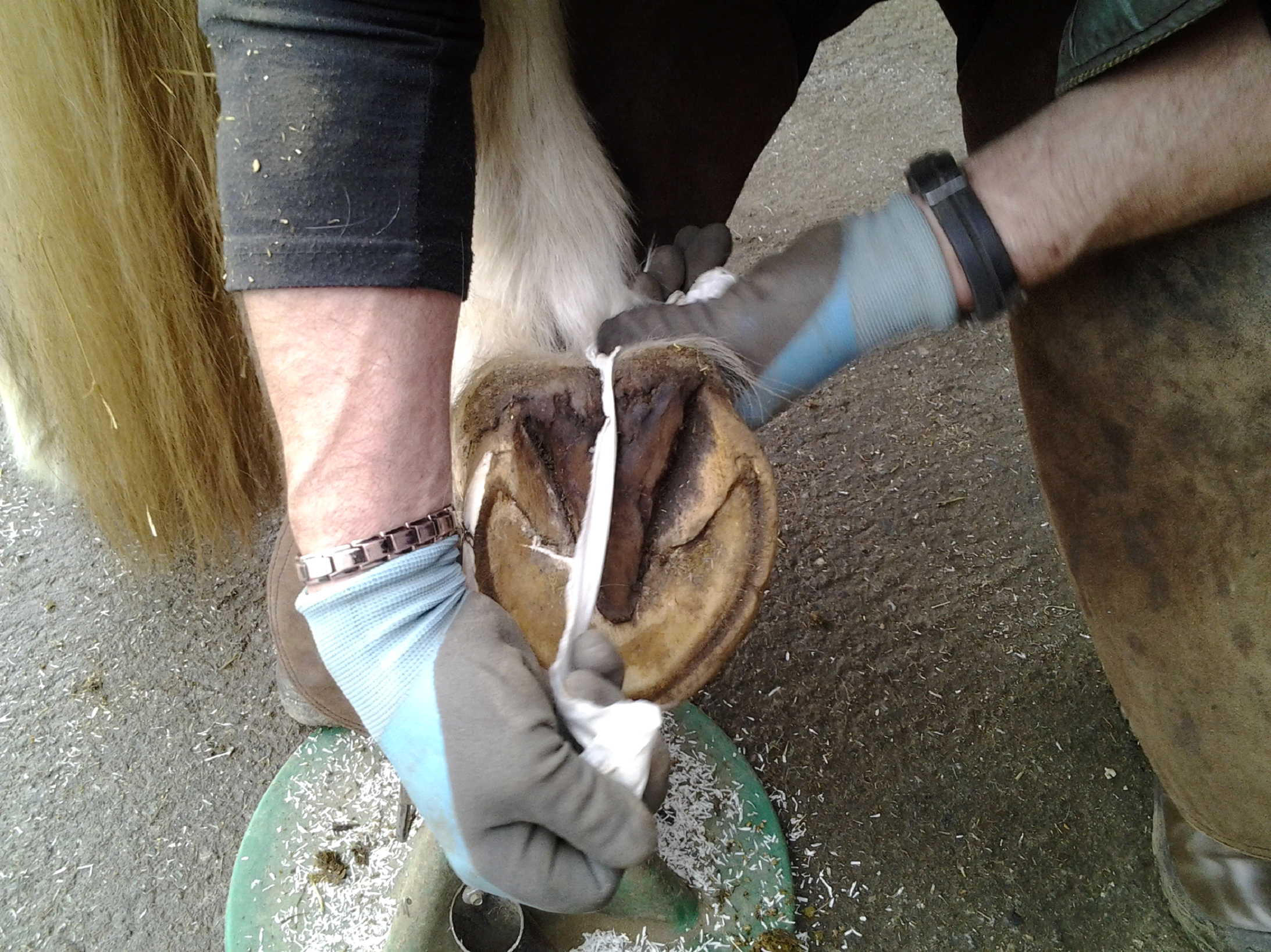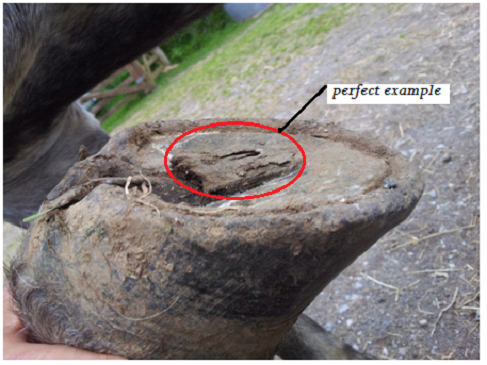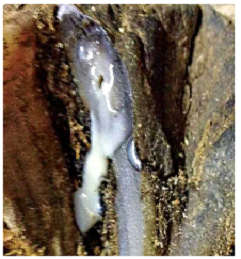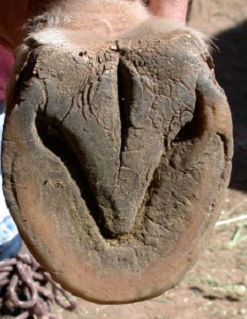Eye of the Foot
Self-healing for the horse’s foot
By Robbie C. Richardson R.S.S.W.C.F.
A paper to encourage owners, vets and farriers to understand more about the need for self-healing within the domesticated equine in order to get healthy and sound feet.
The feral horse seemed to be a good place to start as the only option for the feral horse is self-healing
This is how self-healing works for
The Feral horse’s hoof
Fig 1
Domestic, conventional steel shod horse
Most domestic, conventional steel shod horses will have some compromise somewhere in their feet.
Fig 2
A greater percentage of domestic horses will find it harder from birth to self-heal than its feral counterpart, but a feral horse will not survive when the self-healing can no longer cope.
As a barefoot farrier/trimmer my interest is in encouraging self-healing in the equine hoof.
Since I changed my profession from shoeing, to 100% barefoot trimming and booting, I have been made more aware of the need for a horse to self-heal.
Now when faced with a problem hoof, I need to work-out what it is going to take to start the self-healing process. Before using internal pictures created by either x-ray, MRI scan etc, I have sight, touch and smell as my guide to observe a hoof.
I can see the condition of the wall, sole, bars, heel bulbs, coronary band, and frog surface.
I can feel the condition of the digital cushion, tops of the lateral cartilage, bulbs of the heels, coronary band and thin soles.
I can smell the whole hoof to detect if there is necrotic material either on the surface or coming from within.
As figs. 1 and 2 show, the feral horse has a larger area of being “all well” and larger ‘self-healing areas pre and post problems, also a larger area where if nothing is done the animal will not survive.
Is it possible to have a domestic horse with the self-heal ability of a feral horse?
At this point I must make clear when I use the phrase ‘feral horse’ I mean a horse that was born in the wild, is a member of a herd, has to travel 15-19 miles a day to get enough food and water traversing different terrains and is able to either have or sire foals.
(Worth looking at the work done by Pete Ramey on Mustangs and Chris Pollitt on Brumbies)
Based in the South West of England on Dartmoor, I have the chance to study the native pony, I conclude they are not barefoot, they are horses without shoes.
They do not travel a far enough distance over the correct terrain or eat the right diet to be able to maintain good healthy feet that would work in all conditions, they are just suited for Dartmoor as one would expect.
They have become acclimatised to the, soft, green and forgiving terrain, thus the feet can sometimes have flares, white line separation, thin walls and soles, but seem to self-heal most of the time.
They cope by having feet that are small and upright, except when bred with a bigger horse.
How do you outwardly identify feral hoof from a domestic one?
As a shoeing farrier for 34 years including 13 years mainly working on referral problems at my clinic, I would mainly look at the foot/feet presented, assess the problem using x-rays and scan results, and fit a relevant shoe.
I was not looking at the whole animal, I was not using the signs that were in front of me to assess the self-healing ability of the animal because neither the referral vet/farrier nor I had been taught how to identify them.
I will say that I returned a very high percentage of referrals back to the soundness they were experiencing before having the problem, all be it that I had treated but not cured them.
Move on to when I took myself back to school and started to realise that the way forward for me was to stop putting steel shoes on horses and start to listen and learn to what the horse is capable of doing when given the right diet, conditions and trim.
And although there is not a day that goes by that I don’t learn something; I now am able to do less because I know the horse can do more.
So where to start.
Fig 3
(Pete Ramey pictures)
Looking/touching
I now have a pretty good idea of what each of the different tissues that make up the hoof should look like when they are at their best, (something I only thought I knew when I was shoeing)
A good Wall:
Straight from the top to the bottom, not too upright, not long in the toe, good strong heels, no cracks, splits, holes, unwanted flares ( some are wanted) not worried whether it is a white or black foot, good bonding to the white line all around the palmer surface.
Good Sole:
Healthy, not flaky, waxy in appearance, well calloused in areas of ground contact, well attached to the inner white line, concave from outer rim to frog sulcus.
Good bars:
Good junction with the wall at the heel, upright and straight pointing towards the point of frog, height should be supportive in the heel area.
The Frog:
Consistency of a well-worn leather sole of a shoe, not folding into the sulcus, definition at its point, often (not always) indentation in the central sulcus and the heel area.
A good Coronary band:
Healthy in appearance producing hair from heel to heel no depression no swelling on the surface, and able to produce healthy periople.
Good heel bulbs:
Solid feel, no loose flesh on the surface, should feel like running your finger over the toe of a sued shoe. Both heels even rounded shape due to a healthy digital cushion.
Good Digital cushion: (For me the most important sign of a healthy hoof and sound horse)
Firm rubbery feel with slight depression between the bulbs, filling the caudal third of the hoof extending out and supporting the wings of the lateral cartilage.
Tops of the lateral cartilages:
Should be detectible and be able to palpate slightly.
Smelling:
By putting your nose close to the foot, you will often be able to smell necrotic tissue, after you have cleaned both collateral groves (CG) it is worth smelling again as often the bottom of the CG can be harbouring bacteria that need to be exposed to air in order to neutralise them.
That’s what I know and can teach without any internal pictures.
I also know that a successful barefoot will look and feel closer to a feral horse’s foot than a conventionally shod horse.
Shoeing with conventional steel shoes is detrimental to a horse with good feet, the reason being feral-like feet can do all that a shod foot can, plus be able to self-heal to a greater percentage than that of a steel shod foot.
Lack of shoes is the reason often given by some owners/farriers and vets for sore feet, shoes only cover up why the horse is sore.
Nutrition, condition and trimming are the reasons the horse will give!
For 34 years as a shoeing farrier I did not know this, I do now, and will never nail a shoe on another horse! (I will use boots and stick-on for remedial reasons)
How can we try and create a feral foot on a domestic horse?
Type 1) Foal:
When a foal is born in the wild, it can move up to 7 kilometres on its first day
(BA Hampson,a * JM Morton,a PC Mills,a MG Trotter,b DW Lambb and CC Pollitt)
This will be over all sorts of conditions including hard, soft, sharp, round, sandy, muddy etc.
If you are breeding a foal it is worth thinking about recreating as many of the conditions to stimulate the hoof and create maximum articulation in all joints and tissue as early as possible.
I had an owner who would walk their foals on hard surfaces from day one and the advantage was obvious.
Type 2) Youngstock:
Where possible use a track system (Jamie Jackson Paddock paradise) as this will help simulate natural conditions, including making the horse work for its food.
Type 3) Shod horse that needs to self-heal/transition :
OK, here is the largest section of horses I deal with.
Example: weak heels and frog, long toed and thin soled.
- Check diet, get advice so that the horse is producing good quality tissue
- Create the right conditions for the horse to be on in order to acclimatise the feet
- Start to trim the feet sympathetically in order to support the above
- Think about boots, wraps, stick-on shoes or other methods of helping the hoof to self-heal.
For me the most important sign of self-healing is the development of the digital cushion and frog into a shock absorbing healthy lump of tissue that will allow the horse to land heel first.
Achieve that and you are well on your way to having a healthy self-healing hoof and horse.
Intervention
In this section I wish to concentrate on the frog, due to the owner being able to physically play a large part in its daily health.
Chemical Intervention
It could be that your horse is lame, and the frog seems to be the cause of the discomfort, in which case talk to your professional team.
‘Google vet’ may well have all the advice you need, but please take a moment to consider this:
If you have a good team why would you chose to “go it alone”
If at this point owners are saying to themselves:
“No point in asking my: vet/trimmer/farrier, they haven’t a clue” to which I say you should question your skill as a delegator (owner’s prime job!).
If you don’t think a member of your team has the knowledge or doesn’t give the support you need, CHANGE THEM!
When treating a frog:
- Know the contents of what you are using, and why you are using it (this can be useful for future reference)
- Do not over treat
- Take pictures before and after
Natural Intervention
Facilitate conditions as similar as possible to the feral horse.
Let the conditions do the work for you
- Where possible, a hoof pick, water and a wire brush are the only things I like to use on a horse’s foot.
- If the frogs are too wet, let them dry-out.
- If they are too dry let them soak in spring, river or rainwater.
- Take pictures for reference.
- If you find a hoof is packed with matter before you ride and you can’t see any large stones, leave it packed, this will help with defusing concussion into the CG, always best to clean feet after a ride!
If you want a good hoof, you need a great frog,
If you want a great frog you need a healthy Digital cushion!
Fig 4
(Pete Ramey pictures)
If a horse can’t bear weight on its frog, then it’s unsound, lifting the frog off the ground does not make it sound!
What is a frog?
The frog we see is made from a fibro fatty tissue,(keratinized epidermal layer) it contains anything from 30% -50% water, it is secreted from the sensitive frog which is a mirror image of the one we see, the insensitive frog contains no blood, it is waterproof, shock absorbing, calloused on the surface and always shedding, much the same as our epidermal layer (skin).
Fig 5
(Pete Ramey pictures)
Fig 5 shows all the sensitive parts of the frog, sole, wall and coronary band.
It also contains sweat glands (merocrine glands) that come from the digital cushion. (Fig 11)
(For more information on merocrine glands I recommend paper by Esco Buff, PhD, APF-I, CF)
For the frog to function well:
- The sensitive frog must have a good healthy blood supply (diet and correct concussion) in order to keep up with wear.
- The surface frog must have the ability to shed/peel (aggressive cleaning will help).
- The whole frog must have a balanced amount of concussion and abrasion to keep the outer surface calloused, thick and strong.
The frog is ‘the eye of the foot’ one of its many jobs is to transmit to the horse’s brain via the spinal cord a considerable amount of information in a very short time, for this it has pacinian corpuscles (part of the message system) which are connected to the underside of the frog and have the ability to detect: movement, surface conditions and weight loading, and to transmit this all in a millisecond.
By: R.M Bowker A M Brewer, K B Vex, L A Guida, K E Linder, I M Sonea, A W Stinson
Explains the work done by the pacinians in the hoof
Fig 6
(Bowker pictures)
There is only one type of healthy frog: it is one that can feel the conditions whether they be: wet, dry, soft, hard, round, sharp or deviating from level.
This it will do from the connection it has from the bulbs of the heels, (where many of the sensitive receptors are), to the point of the frog.
When we talk about a ‘heel landing’ we also mean a rear frog landing, pain in the rear of a frog will contribute towards a toe landing and contracted heels.
The healthy frog will make sure the horse can: grip the surface it’s on, assist in pumping blood and it will try to normalise blood distribution in the hoof’s caudal third when there is a deviation in the skeletal or hoof tissue due to biomechanical compromises. It will do this in the caudal third using the frog stay which is under the frog’s central sulcus.
If that is not a clever piece of kit, I don’t know what is.
Frog Quality
Your horse should have 4 good ones, not 3 and that nasty one, not 2 nice back frogs but 2 manky looking things hidden in black holes in front.
Definitely not: 4, weak, non-existent smelly flaky bits of old wet rubber that are sensitive to touch.
Please get the diet right before you do anything about trying to treat poor frogs.
Some frog’s poor quality on the surface can be due to something that happened a while ago, as it takes time for the bottom layer to become the surface layer, this can be common in laminitics. Frog damaged tissue can appear for no reason some time after the laminitic attack.
If your horse has a surface infection look for causes, such as poor conditions under foot or things like chicken manure (a real no-no for me).
Maybe the frogs have been covered for a long period of time with pads or have been protected by chemical means.
Different types of poor frogs
Fig 7
(fig7) Different layers of this frog are still hanging on to try and get purchase on the ground, (especially towards the toe) but due to the lack of heel landing the wall has grown down and forward too far, the frog cleft has tried desperately to keep some sort of lat/med balance internally but has ended up being divided too far up into the heel buttress, thus giving pain in the central sulcus.
Fig 8
(Fig 8) This 9 year old foot had been shod for six and a half years, there was no strength in the wall or heels, the frog has never had a real chance to do its job, so it gave up (due partly to diet) also, due to lack of ground contact
and movement, it could not maintain shape or form.
The frog will take longer to get right than the entire rest of the foot.
Fig 9
(fig 9) The two flaps of frog by the heel are trying desperately to give some frog pressure, but due to the long heels it is virtually impossible, the frog is healthy enough to be able to take weight after gradually lowering the heels and getting the break over back.
Fig 10
(Fig 10) This foot has a large frog but pain at the rear due to contracted heels and lack of use, a real ‘catch 22’ as you need a heel landing to widen the foot but you can’t have one because of the caudal pain. This frog needs to be treated and cured first; if you trimmed the heels down you would make things much worse.
So, who or what is responsible for bad frogs in the domestic horse?
Well we are! but then again, we are also responsible for having good frogs.
So how can my horse get good frogs?
First: diet, then conditions, then diet, then conditions then diet, then trimming.
There are loads of treatments for frog problems, (I think I have used them all!), always get the advice from your team as to which would be best.
Keeping a frog clean by scrubbing with a firm brush and salt water, cider vinegar / water solution, or a recommended preparation will help stop a lot of external problems.
With bad central cleft problems including thrush I like to use a clean cotton pull-through (roughly 120 cm by 5 cm old sheet) to see what has been harbouring in there. (Fig 11)
Fig 11
Diet:
Like our skin, you can put on many preparations that may treat surface problems but often you need to look deeper.
The diet is what you allow the horse to take into its body.
Food enters the horse to supply energy; it segregates it into the relevant parts:
Energy: to look for more food, keep warm, be ridden, and cope with stress.
Energy: for self-healing, this is where the horse must be internally fit enough to: absorb and knit bone, form scabs, heal wounds and generally balance itself.
Energy: for growth to either form into an adult or replace what it has: bones, skin, hair, hoof wall, sole, bars etc, including FROG!
A horse should be fed little and often: (a feral horse can eat 18 to 20 hours) to give it one big bucket of food will often mean the stomach will not have time to segregate it into the relevant parts, the rear gut then has to try and deal with items it does not recognise, thus leading to aliments like laminitis, colic, and others.
The job of the owner is to identify the needs and supply them in the correct way.
NO MORE, NO LESS!
A feral horse will have good frogs, it must, it could not survive if it didn’t and it does it through eating the right diet at the right time living on the right conditions.
So, when it comes to diet, get advice, try and keep it simple. It is easier to add energy than to visit a tack shop to buy something to hold excess energy back.
You will not find your horse’s needs written on a food bag:
What you will find on most bags are the contents, written on a small label or in a box in the bottom corner in a language that food manufactures have developed over years of needing to confuse an owner. (The people who read and understand these, also read the terms and conditions on a phone contract!)
What you will find written in large letters on the front of the bag is:
JUST RIGHT FOR YOUR HORSE
EVERYTHING YOUR HORSE NEEDS
NO MORE LAMINITIS
GO HIGHER, GO FASTER
BALANCE YOUR HORSES GUT
SPOOKY NO MORE (the calming food made for your horse)
They know that the front of the bag is what sells it, not the ‘contents’.
They will however write, ‘Contains: herbiestuff or calmyoudown, which has been scientifically proven to do what we say’.
For example: ‘contains biotin for encouraging hoof growth’. Well that’s good isn’t it? of course it is, but how good is it? How much biotin should they have? Why does my horse need it? Does this contain the right amount? If I stop feeding it will my horse’s feet get worse? Is there a natural way I can get biotin into my horse’s diet?
There are some horse- food companies that are doing their best to be as clear and honest as they can, but it is virtually impossible to buy a bag of foodstuff that is totally natural to the equine diet, horses are meant to roam the plains looking for tufts of grass drinking: river, rain or spring water, and covering approx 16 miles a day. (C. Pollitt study of brumbies)
Healthy herd of feral horses!
If it is that time of year when the grass is green and rich (to them) that’s when they are: foaling, lactating, protecting their herd, fighting etc. that would be the spring and early summer… HELLO! isn’t that when domestic horses that are not doing any of the above tend to get laminitis!
Ok that’s torn it apart
Let’s start to put it back together.
First, find out what your horse needs.
This is the energy it should take in to fulfill all its needs, this will be based on a percentage of your horses weight in dry matter food intake, this is for energy plus other nutrients for condition and growth, if you know this… well done, if not talk to an independent equine nutritionist, they will know.
The information they need will have to be accurate: weight and size of your horse, how much work the horse does, plus condition; this should include the state of the feet INCLUDING THE FROGS.
Conditions
If a feral horse producing good frogs stands in wet conditions, the frog may get softer but not worse, if it is standing on predominantly hard ground the frog may become as hard as the surrounding tissue, but it will still be a good frog, the horse will try and maintain a balance in order to keep a strong thick consistent, shock absorbing frog.
Frog management for the feral hoof is relatively easy: kept on the right diet in the right conditions the frog will shed/wear away and maintain clean uninfected groves (sulcus) each side of the frog by moving on sand, gravel, rocks and packed soil.
Managing the domestic barefoot frog is not so easy:
Where possible an owner needs to create surfaces that will include: dry, wet; abrasive, slippery, and soft, by using different materials like sand, bark, pea gravel, logs ( to make them lift their legs) in fact the more surfaces you create the better your horses feet (and frogs) will be, also making it easier for the horse should they be going through transition. A lot of my clients have created a track system (Paddock paradise by Jamie Jackson) this will also help an amazing amount.
Fig 11
(Picture aanhcp .net)
A barefoot farrier or trimmer should know how much frog would have been naturally worn away or shed when it comes to observing the foot that is being trimmed, they will only remove the tissue that is not needed, rather than take away tissue for esthetical reasons!
Fig 12
Very neat, but was it necessary, I was guilty of doing this for too many years!
Would you pull or cut a protective scab off a wound? If it’s well attached LEAVE IT THERE!
I do use a hard resin coating (Rockgel) to protect the insensitive tissue on the frog and sole when presented with a weak hoof. (more in Products)
Often you will observe a frog that is not in good condition generally, but there is a lump of moderately healthy frog from about halfway down to the point of frog (Fig 13)
In my opinion this is to resist the force of the deep flexor tendon and exists to try and create a dorsal/caudal balance if it is there, LEAVE IT!
Fig 13
The merocrine glands (sweat glands) can sometimes get blocked causing a build-up of milky fluid, this is often exposed when cutting through frog tissue, there is no need for alarm, but a sign that the frog surface may need more abrasive cleaning. (As it would in the wild) (Fig 14)
Fig 14
(Heather Smith Jones picture)
Fig 15
(Western Dressage ass)
This is a competitive barefoot horse’s foot that if I had been asked to shoe 12 years ago, I would have said it has no foot, the horse would have disagreed!
Self-Healing:
Remember that horses can self-heal to a large percentage given the right conditions:
I would implore any trimmer or farrier to get to know what a healthy frog looks like.
To over trim a frog could lessen its ability to function until the frog tissue has re-grown.
The 3 most dangerous tools a trimmer or farrier carry are a knife, rasp and nippers, because they all remove tissue. (I will never sicken of saying it)
The closer to the surface the pacinians sensors are (ref fig 6) the more they will react. “My horse was footy after a trim” is something that is quite common to hear. If you make the frog too sensitive (not painful) it can often give this result.
In this wonderful age of us all having cameras on our phones, take pictures of your horse’s frogs, study them, and get to know how they look at different times of year, and in different weather conditions, when they may shed, when they are at their smallest, biggest, most sensitive, strongest or most robust.
Don’t be afraid to ask owners of sound, hard-working barefoot (or shod) horses if you can look at their horses’ frogs, you may learn a lot.
If you have a professional team that talks to each other then you will have less need to worry.
Steel shoeing a horse does not mean you don’t have to manage the feet, especially the frogs!
In closing
Getting a healthy frog and digital cushion is, in my opinion the first and most important job of the team, achieve that and your horse has started the self-healing process.
It takes time
For the owner of a horse that is going through transition to barefoot this is the hardest part of the journey, you need support and knowledge.
I have been a farrier for 46 years, 12 years ago I changed my business to 100% barefoot trimming and boot fitting, I have learned that I am unable to keep a barefoot horse working and sound without the cooperation of my fellow professionals and conscientious owners.
For 34 years I was putting steel shoes on horse’s feet in order to keep them or make them sound. I now realise I was treating not curing.
If a horse can’t go sound without shoes on any surface, it is not sound, (something worth thinking about when buying a horse!)
Together we must improve the knowledge that is so rightly needed to keep horses sound, we must break down any barriers that exist between professionals when it comes to the shod or barefoot horse.
All horses can go barefoot, but I fully understand not all owners have the facilities or time to do it, I just want to share the fact that for the owners who do, there is another way!
All horses, steel shod or barefoot deserve to have sound and healthy feet.
Horses can teach us how.
Self-healing for the horse’s foot
By Robbie C. Richardson R.S.S.W.C.F.

